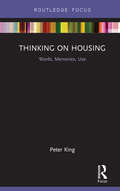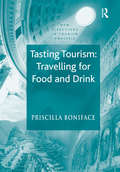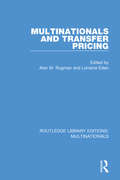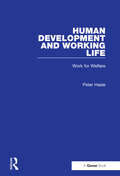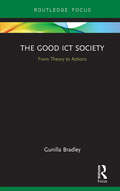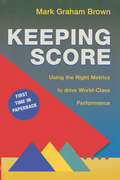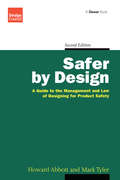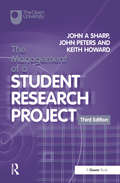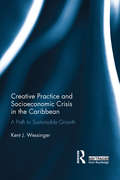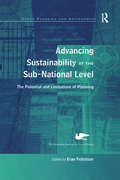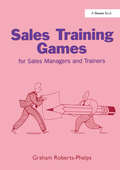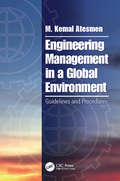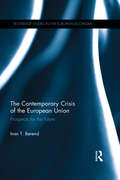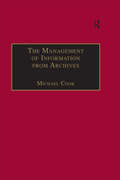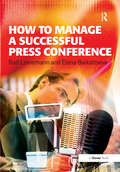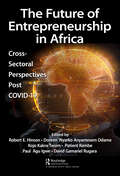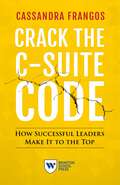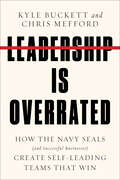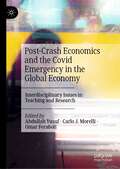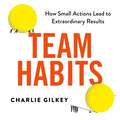- Table View
- List View
Thinking on Housing: Words, Memories, Use (Routledge Focus on Housing and Philosophy)
by Peter KingIf we do stop to think on housing, what do we see? What is housing and what does it do? These seem deceptively simple questions, but they are often left unanswered. The reason for this is that a lot of discourse on housing is really a concern for policy-making and the critical evaluation of existing policies. Discourse, is not, properly speaking, on housing at all. It is concerned with provision, distribution and access, but this thinking on housing stops at the front door. It is only concerned with what is actually external to housing. But for most people, housing already exists and they have access to it. Housing is not then about policy, but about how we can use what is a complex object in a manner that allows us to live well. Housing, for most of us, is about what we do when the front door is firmly shut and we are free from the external world. These essays explore this idea of housing as an object that exists for use. Housing is pictured as an object that contains activity. These pieces look at what we do with housing once we have it and so provides a necessary underpinning for any understanding of why housing is important. A further purpose of these pieces is to present different ways of thinking and writing on housing. It is an attempt to show that housing is a suitable topic for philosophical discourse. It is suggested that we can and should seek to establish a philosophy of housing, rather than just relying on the traditional social sciences.
Interaction for Designers: How To Make Things People Love
by Brian L.M BoylInteraction for Designers shows you how to connect a product with its users, whether it’s a simple toaster, a complex ecosystem of intelligent devices, or a single app on your smartphone. This book covers the entire design process so you can start with an idea and carry it through to an engaging final design. It carefully leads you step by step and richly illustrates each stage with examples drawn from business communication, social media and the social economy, consumer electronics, architecture and environments, health care, psychology, art and culture, education, athletics, automotive design, entertainment, fashion, the family home, and a wealth of others. You’ll learn how to brainstorm ideas, research them, explore them, evolve them into finished designs, pitch them, all with the goal of helping you make things that people love. Includes over 200 color images, a glossary, and links to web resources highlighting design concepts and designer interviews. http://interactionfordesigners.com/
Tasting Tourism: Travelling for Food and Drink (New Directions in Tourism Analysis)
by Priscilla BonifaceAlong with basic practical reasons, our practices concerning food and drink are driven by context and environment, belief and convention, aspiration and desire to display - in short, by culture. Similarly, culture guides how tourism is used and operates. This book examines food and drink tourism, as it is now and is likely to develop, through a cultural 'lens'. It asks: what is food and drink tourism, and why have food and drink provisions and information points become tourist destinations in their own right, rather than remaining among a number of tourism features and components? While it offers a range of international examples, the main focus is on food and drink tourism in the UK. What with the current diversification of tourism in rural areas, the increased popularity of this type of tourism in the UK, the series of BSE, vCJD and foot and mouth crises in British food production, and the cultural and ethnic fusion in British towns and cities, it makes a particularly rich place in which to explore this subject. The author concludes that the future of food and drink tourism lies in diversity and distinctiveness. In an era of globalisation, there is a particular desire to enjoy varied, rather than mono-cultural ambiance and experience. She also notes that there is an immediacy of gratification in food and drink consumption which has become a general requirement of contemporary society.
Multinationals and Transfer Pricing (Routledge Library Editions: Multinationals)
by Alan M. Rugman and Lorraine EdenOne of the reasons for the success of multinational enterprises in their ability to create in their supranational organisations "internal markets" which eliminate the imperfections of external world markets caused by tariffs on trade, restrictions on the flow of capital, information costs and so on. The method multinationals use to create and sustain internal markets is transfer pricing. Multinationals use to their advantage the difference between nominal accounting and real transfers from their head offices to a subsidiary in different countries to overcome transaction costs and restrictions on trade and capital flows. This book, first published in 1985, examines these and other aspects of multinationals’ use of transfer pricing. It puts forward original thinking and research findings by leading experts in this area. Empirical results are related to the activities of multinationals in less developed countries. This volume covers the economic theories of transfer pricing, accounting and fiscal practices and implications for government policies and regulations, and will be of interest to students of economics and business studies.
Human Development and Working Life: Work for Welfare
by Peter HasleHuman Development and Working Life - Work for Welfare explores whether the development of human resources at company level can improve individuals' quality of life, company's possibilities of development, and welfare and democracy in society. The book refers to cases where attempts have been made to improve quality of working life and competitiveness of the company. Possibilities and hindrances to combine social improvements and competition in the development of human resources are discussed. During the last 10 years most European countries have increased investments in the development of human resources at work as a vehicle for social development. The public investment in training, rehabilitation and support for innovation has increased; and at the same time the labour market has been deregulated to remove obstacles for flexibility and business development. The aim of the book is to promote knowledge about how to integrate social development and flexibility at the company level.
The Allocation of Health Care Resources: An Ethical Evaluation of the 'QALY' Approach (Medico-Legal Series)
by Peter Singer John McKie Jeff RichardsonThe competition for limited health care resources is intensifying. We urgently need an acceptable method for deciding how they should be allocated. But the goods that health care produces are of very different kinds. Health care can extend the lives of children and of older people. It can make it possible for a person to walk, when without health care that person would be permanently bedridden; and it can reduce the pain and distress of people who are terminally ill. How can we possibly decide which of these - and many more - diverse achievements of health care are more deserving than others? We need a common unit by which we might be able to measure these very different goods. The Quality-Adjusted Life Year, or QALY, is the most developed proposal for such a unit of measure. In this book a distinguished team of ethicists and economists defend the core of the QALY proposal: that health care resources should be used so as to produce more years of life, of the highest possible quality. This leads to a discussion of such fundamental questions as whether all lives are of equal value, whether health care should be allocated on the basis of need and whether the QALY approach incorporates an adequate account of fairness or justice. The result is the most thorough account yet of the ethical issues raised by the use of the QALY as a basis for allocating health care resources.
The Good ICT Society: From Theory to Actions (Routledge Research in Information Technology and Society)
by Gunilla BradleyWhat is Quality of Life in a society that has embraced information and communication technology (ICT)? What is Wisdom in this kind of society? And what things are helping or hindering us from having both wisdom and a good quality of life in ICT societies? #65533; Taking the reader through a quick analysis of the current social and psychological changes in the Information and Communication Society, Bradley challenges us to avoid becoming victims of technology - whether we are professionals, policymakers, parents or citizens. Indeed, she introduces a theoretical model based on four decades#65533; worth of research to help the reader to understand this complex, technological world. In addition to focusing the reader#65533;s attention on convergence and acceleration, this model describes the interplay between technology, societal structure, organizational design and human roles, thus leading to what Bradley describes as a "good ICT society". #65533; Emphasising the necessity of a co-operative parallel between the automation and humanization of society, this innovative volume will be of interest to undergraduate and postgraduate students and postdoctoral researchers interested in the subjects such as Information and Communication Technology and Social Change, Psychology and Sociology, Computer Technology and Media Technology.
Keeping Score: Using the Right Metrics to Drive World Class Performance
by Mark Graham BrownIn Keeping Score, the author contends that metrics must be all-encompassing. They must focus not just on the present, but need to consider the past and future. They also must consider the needs of all participants, including customers, shareholders, and employees. Still one must know exactly what to measure, as measuring everything can be more damaging than measuring nothing. Taking a balanced Baldrige approach, this book shows how to evaluate current approaches to measurement and pinpoint false measurements. It covers the selection of financial metrics, ways to measure employee and customer satisfaction, and methods to track performance and measure quality.
Safer by Design: A Guide to the Management and Law of Designing for Product Safety
by Mark Tyler Howard AbbottProduct safety begins with design or formulation whether it is for a complex engineering product or a simple household article. Those who suffer damage from a design defect can win compensation without having to prove negligence. Manufacturers, suppliers and importers can all be responsible for ensuring that their products are safe. To help protect them against prosecution, customer dissatisfaction and commercial loss requires a programme of risk reduction, which begins with the management of design. Design and product development require a balanced approach to the new realities of the legal situation, both for companies and individual designers. Part One reviews the strategy needed to manage design in the fresh legal climate and includes guidance on techniques that can be used. Part Two is a jargon-free guide through the difficult area of international product liability law. It has been entirely rewritten to reflect the many recent changes to influence European law and a designer's personal liability. Part Three brings home vividly the physical, legal and commercial risks of product defects and demonstrates ways in which they could be prevented. There are over 20 real life, fascinating and instructive case histories, many of them new, ranging from exploding office chairs to ro-ro ferries and from washing powder to aircraft. Safer by Design is exceptional in providing management and risk assessment advice, coupled with legal guidance and actual practical lessons.
The Management of a Student Research Project
by John Peters John A SharpThe third edition of this popular book has been extensively revised to reflect the changes that have affected student research in higher education in recent years. The ability to carry out research successfully has come to be seen as a 'key transferable skill' required of all higher education students - and The Management of a Student Research Project addresses directly the skill element of this. Furthermore the research process, at all levels, is far more systematized than in the past. The single largest change since the second edition came out in 1996 has been the impact of the World Wide Web on student research. The third edition has been thoroughly rewritten and developed in response to this. In particular, Chapter 4, 'Literature Searching', has been structured around a sample online search. Throughout, the comments and thoughts of readers of previous editions have been taken into account in framing this third edition. Its aims remain the same - to provide a clear, comprehensive and useful guide to students undertaking research projects in order to improve their chances of a successful outcome.
Creative Practice and Socioeconomic Crisis in the Caribbean: A path to sustainable growth
by Kent J. WessingerAlthough the world is saturated with extraordinary methods, innovation, and technology, the Caribbean seems to have been left behind in the sustainable growth of global development. While the majority of the world defines the Caribbean as "paradise," the reality of life for Afro-Caribbean culture is defined by an unrelenting hardship. This book comprehensively analyzes this phenomenon from a unique and intimate perspective in order to offer a viable pathway to sustainable growth. By examining the historic progression of the Caribbean region and the African culture within, the author explores the relationship between creative practice and socioeconomic crisis and questions whether limited access to environments that facilitate original and conceptual ideas correlates with socioeconomic crisis. The outcomes and methods of analysis developed in this book are a useful tool for other cultures or organizations seeking to diffuse socioeconomic crisis and implement a pathway of sustainable growth. This innovative book will be of great interest to students and scholars of cultural and sustainability studies, Caribbean and African Studies, as well as Development and Sustainable Development
Advancing Sustainability at the Sub-National Level: The Potential and Limitations of Planning (Urban Planning and Environment)
by Eran FeitelsonSustainability notions have been widely embraced by planners. However, the question of what can planners contribute to the advancement of such notions has not received much attention until now. This volume examines the potential contribution of planning to the advancement of sustainability at sub-national level, and the limitations it faces in doing so. Bringing together case studies from the US, UK, Poland, Israel, South Africa, The Netherlands and Italy, it covers a wide range of issues and contexts, ranging from the metropolitan to the community level. On the basis of these case studies, the book shows that planners do indeed have a variety of options to advance sustainability notions at these levels, and appear to be doing so. The book proposes that planners should operate at two levels: firstly to change institutional structures, and secondly to advance sustainability notions incrementally in the meantime, within the existing institutional constraints.
Sales Training Games: For Sales Managers and Trainers
by Graham Roberts-PhelpsSelling is a skill that should not be limited to sales staff. Customer service, or other support staff, could all benefit from developing an awareness of and an ability to sell to customers. Also, the opportunity for developing those skills should not be limited to sales training workshops. Here, at last, is a mix of over 80 games, exercises and ideas that can be used to develop sales, customer service and other staff. They range from simple ’skill boosters’ for coaching sessions or team meetings, through icebreakers, energizers and selling quizzes to full blown role plays and case studies. The principle at the heart of all the material is that games and exercises should be generic - transferable across different organizations and sales situations - and that they should use an 'open content' approach. This means that participants must supply their own examples and experiences, to make the material immediately and completely relevant. This collection of games and exercises will enable sales managers or trainers to: ¢ develop their people with confidence, secure in the knowledge that all of the material has been thoroughly road-tested on courses and seminars; ¢ ensure a flexible approach, varying their pace or style in response to the subject matter and their audience; ¢ reinforce the learning, using different formats of exercise to cover the same learning points; ¢ train (rather than talk), using the material to encourage people to start using what they already know.
Engineering Management in a Global Environment: Guidelines and Procedures
by M. Kemal AtesmenIn today's global business environment with high speed interactions, engineering organizations are evolving continuously. Engineering Management in a Global Environment: Guidelines and Procedures provides guidelines for changing roles of engineering managers in the international arena. The book covers global, multidisciplinary, and flat engineering organizations. Recommended procedures for hiring, mentoring, work assignments, and meetings in the global arena are detailed. Guidelines for keeping up with technology and with the changing world, performance reviews, layoffs, necessary engineering tools, and work atmosphere are discussed. Procedures for engineering team building and for having good relationships with upper management, customers, subcontractors, and regulatory agencies are provided. Each chapter ends with a checklist summarizing engineering managerial guidelines in that chapter.
The Contemporary Crisis of the European Union: Prospects for the future (Routledge Studies in the European Economy)
by Ivan T. BerendThe European Union widened and deepened integration when it introduced the Single Market and the common currency, increasing the number of member countries from 12 to 28. After a quarter of a century, the 2008 financial and economic crisis opened a new chapter in the history of European integration. Prosperity was replaced by economic crisis and then long stagnation, with ramifications far beyond the economic arena. For the first time, after more than half a century, some countries were almost forced to step out of the Union. History’s most frightening migration crisis shocked Europe and led to the strengthening of several anti-integration parties in various countries. This pioneering book discusses the nine crisis elements that could lead to disintegration of the EU. Beginning with the Greek Debt disaster this book delves into the cause of the recent European crisis and then onto the recent immigration influx and its consequences, as well as Britain’s exit from the Union. A concluding chapter, based on the facts of positive development during the crises years, gives a cautiously optimistic forecast for the future and asks the question: further integration or disintegration? This volume is of great importance to academics, students and policy makers who have an interest in European politics, political economy and migration.
The Management of Information from Archives
by Michael CookThis authoritative guide to the principles and practice of archives management in private and public sector organizations has been substantially revised. It now provides detailed advice on changes in national and international standards and approaches, in particular ISAD(G) (International Standard Archival Description) and ISASAR(CPF) (International Standard Archive Authority Record). The new edition also includes guidance on the interpretation of the Manual of Archival Description, also published by Gower. Michael Cook takes the reader through the history, definition and function of archives and archival services, international service models, staffing and resource issues. He explains how to set up and run a records management programme, manage the interface with archival management, conduct a records survey, set up retention schedules and organize appraisal, acquisition and disposal in a way which ensures the service meets organizational and individual needs. Chapters covering the arrangement, coding and description of archival material, and the administration of its physical storage, demonstrate how efficient management facilitates the accessibility of archival information. The book concludes with chapters on computing and user issues, such as rights of access, Freedom of Information, security and data protection standards. This key reference on best practice is intended for students and lecturers in archives administration and records management, and for archives and records managers, particularly those newly qualified or seeking professional registration. Managers without formal qualifications but responsible for records or archives management, and information managers working with archivists and records managers, will find it helps to improve working methods and to run a more effective archives service within the modern information management environment.
International Investment Law and Policy in Africa: Exploring a Human Rights Based Approach to Investment Regulation and Dispute Settlement (Routledge Research in International Economic Law)
by Fola AdelekeThis book studies the international investment law regime in Africa and provides a comprehensive analysis of the current treaty practices in Africa from global, regional and domestic perspectives. It develops a public interest regulation theory to highlight the role of investment regulation in sustainable development and the protection of human rights. In doing so, the book identifies seven factors that should be considered by arbitrators in resolving international investment disputes that affect the public interest. It considers how corporations can be held accountable through investment treaties in the absence of a global treaty on business and human rights while protecting the rights of investors and their investments. Furthermore, the book explores the current objectives and features of investor-state dispute settlement (ISDS) as well as the deficiencies and its intersection with the rule of law. It identifies alternatives for ISDS and the extent to which these alternatives address the objectives of attracting investment, depoliticise investment disputes, promote the rule of law and offer remedies to investors. These solutions are offered in relation to the protection of human rights, the promotion of sustainable development and the right of states to introduce domestic public interest regulation. Finally, the book takes a prospective stance and discusses future trends for dispute settlement and investment rulemaking in Africa.
How to Manage a Successful Press Conference
by Ralf Leinemann Elena BaikaltsevaDespite the ubiquity of new forms of communication technology, press conferences remain a vital way for companies to share news. One size or message does not fit all and the content showcased must be of interest to every member of the audience. This book highlights the importance of understanding the needs of those who will attend; an ever-more critical skill as stretched editorial teams make it increasingly difficult to lure journalists from their desks. In the international press arena, journalists from different countries have particular needs and can react differently to the same situation. The authors show that to ensure success, PR professionals need to take account of the event, speakers, style, content and tone; and follow through to the all-important tasks of obtaining feedback and analysing results. How to Manage a Successful Press Conference is essential reading for PR teams working in a national or, particularly, an international environment and enables you to address the whole range of activities necessary for success, from the basics through to advanced issues such as managing press expectations across borders and cultures.
The Future of Entrepreneurship in Africa: Cross-Sectoral Perspectives Post COVID-19
by Robert E. Hinson, Doreen Nyarko Anyamesem Odame, Kojo Kakra Twum, Patient Rambe, Paul Agu Igwe, David Gamariel RugaraEntrepreneurial and Small Business Development in Africa focuses on entrepreneurial development and the development of small businesses in Africa. The central idea of this book is that entrepreneurial development and small business development are connected. Entrepreneurship is lauded as an engine of growth (economic development and job creation), with small businesses often contributing to new job creation. Also, entrepreneurship and small business development are the heart of many countries’ economies. The decision to focus on entrepreneurial development and small business development is that first, there is a consensus that most entrepreneurial activities are aimed at creating small new ventures. Second, countries that give special attention to entrepreneurship stand a chance of industrialization. Third, Africa has been reported as having a rich entrepreneurial landscape as the continent’s wealthiest individuals generated their wealth as trailblazing entrepreneurs. Fourth, small-scale entrepreneurs and businesses form the backbone of economic activities across the continent. A motivation to focus on entrepreneurial and small business development is the generally accepted view that start-ups in Africa are growing calling for understanding into how to enhance productivity, efficiencies, and application of new technologies. The book aims to enhance the understanding of stakeholders (business owners, governments, practitioners) to overturn challenges such as inadequate start-up capital, competition, lack of employees with the right skills, and low use of technology. The ability to develop entrepreneurship in Africa, and the role of small-medium enterprises cannot be underestimated. The promotion of entrepreneurship in Africa is crucial as it creates jobs, provides decent livelihoods, and contributes to GDP. Most entrepreneurial initiatives in developing economies entail identifying opportunities and new venture creation. It is worth recognizing that most new ventures created take the form of small businesses and the entrepreneurial processes involve entrepreneurs’ knowledge and skills, identifying opportunities, involvement in setting up a business and managing the business. The various aspects of this book focus on many entrepreneurial activities that are undertaken on the African continent. This book is focused on African countries since there is a reason to be optimistic about the prospects for growth and entrepreneurship. To achieve entrepreneurial success in African countries, the African Development Bank (2021) proposes that there must be a link between macro and firm-level characteristics that will serve as the mix of entrepreneurship in societies. This book, therefore, considers some macro-level factors such as education, training, and skills development, technological developments, government programs, and entrepreneurial challenges and opportunities. At the firm-level, this book focuses on entrepreneurial initiatives such as branding and marketing.
Crack the C-Suite Code: How Successful Leaders Make It To The Top
by Cassandra FrangosAn insider's guide to creating your own path to the corner office How can I reach the C-suite? That is the most common question Cassandra Frangos hears from the executives she coaches. Many aspire to reach the C-suite, but the typical paths to the top are hard to find and difficult to follow. In Crack the C-Suite Code, Frangos reveals the hidden dynamics for reaching C-suite. She offers expert guidance based on her experience as a consultant at Spencer Stuart and former head of global executive talent at Cisco, a company with 70,000 employees. Her deep research on the topic includes candid interviews with CEOs, hundreds of aspiring C-suite candidates, and the leading experts in the field. Frangos identifies four core paths you can follow to reach the C-suite: The Tenured Executive, The Free Agent, The Leapfrog Leader, and The Founder. To actively improve your chances for success, she presents: •Insider knowledge from current CEOs and well known executives•Guiding questions that clarify the risks and rewards associated with each path•Accelerators and derailers that either enhance or detract from your chances to succeed•Advice on how to leverage your experience, leadership brand, and mindset to help you land on the c-suite short list•Insight on how the evolving role of the CEO affects your strategy to reach the top A career playbook for anyone who aspires to the top spot, Crack the C-Suite Code features advice from successful C-level leaders, including Accompany's Amy Chang, Goldman Sachs' Edith Cooper, Nest's Yoki Matsuoka, Cisco's Chuck Robbins, and Corning's Wendell Weeks. These and other top leaders from a broad range of companies, including Microsoft, Google, and General Electric, tell the stories of their success and help aspiring executives crack the C-suite code.
Transformative Negotiation: Strategies for Everyday Change and Equitable Futures
by Sarah FedermanA contemporary guide to negotiation that centers an understanding of power Transformative Negotiation advances an understanding of power and oppression as core to negotiation, arguing that negotiation is central to social mobility and social change. Bringing theory into action, the book explores the real-world examples that Sarah Federman’s own students bring to class, such as negotiating with courts to get their kids back or with the IRS to reduce late fees. Federman explains how heritage, ethnicity, wealth, gender, age, education, and other factors influence what we ask for and how people respond to our requests, as well as what is at stake when we negotiate. This book provides tools to help readers gain confidence in their everyday negotiation skills and link personal success to social transformation.
Leadership Is Overrated: How the Navy SEALs (and Successful Businesses) Create Self-Leading Teams That Win
by Kyle Buckett Chris MeffordAn award-winning pair of executive consultants reveal why to be successful, businesses need self-leading teams, not just good leadership. “In a society so obsessed with leadership, why are we so bad at it?”Despite the countless seminars, courses, and management books designed to hone good leaders, over 79% of employees leave their jobs due to poor leadership. Why is this happening? Award-winning executive consultant Chris Mefford and retired, high-ranking US Navy SEAL trainer Kyle Buckett argue that organizations need more than just leaders. They need successful teams.Mefford and Buckett are passionate about how our leadership model has failed and spotlight a new work culture that actually works. In Leadership Is Overrated, they draw on the SEAL model and on their decades of knowledge and experience coaching industry leaders to answer the question: what makes a productive team? The surprising truth is that behind every successful team is a cadre of empowered, self-starting employees.In this revolutionary guide, Mefford and Buckett share crucial leadership strategies to help organizations revamp their work culture, throw out stifling hierarchical leadership models, and embrace a dynamic, results-oriented, and successful self-led team-oriented model instead.
Post-Crash Economics and the Covid Emergency in the Global Economy: Interdisciplinary Issues in Teaching and Research
by Abdullah Yusuf Carlo J. Morelli Omar FeraboliThis book continues the ongoing debate about the need for alternative, interdisciplinary and heterodox approaches to teaching economics at university. It deals with challenges currently faced by economists, pursues an interdisciplinary approach to enhance collaboration with academics from disciplines other than economics, and analyses several questions and issues related to the 2007-08 financial crisis and the current Covid-19 emergency. The Covid pandemic has shown the flaws of the current neoliberal model and the inability of mainstream economic theory to address the problems created by the pandemic. The book engages with an academic audience interested in incorporating a wider range of economic approaches in their research and teaching, and with undergraduate and postgraduate economics students who are trying to understand the limitations of their current economics syllabi. The novelty of the book is the active involvement of undergraduate and postgraduate students who contribute to this volume with three chapters. The book will be of interest to a wide range of researchers, students and teachers interested in interdisciplinary and heterodox economics.
Team Habits: How Small Actions Lead to Extraordinary Results
by Charlie GilkeyWe all know how important our habits are for personal productivity, success and happiness. But the truth is that we rarely work alone: reaching our goals depends on how effectively we work with others, and teams have their own habits that can help - or hinder - success.Here, productivity and teamwork expert Charlie Gilkey shows how to cultivate, implement and maintain the small habits that lead to big results for any team. No matter our job title or role, we all influence the people we work with, and the culture that we create: how we schedule meetings is a team habit, as is the way we cc, bcc or Slackeach other, communicate our availability, set our boundaries and structure our days.They can make the difference between teamwork that feels like a struggle, and collaboration that empowers everyone to deliver their best. Starting with the Team Habits Quiz, and full of clear, applicable takeaways oneverything from communication to morale to creating a sense of belonging, this book is essential reading for anyone who works in a team and wants to get further, together.
The Rise and Fall of the EAST: How Exams, Autocracy, Stability, and Technology Brought China Success, and Why They Might Lead to Its Decline
by Yasheng HuangThe long history of China’s relationship between stability, diversity, and prosperity, and how its current leadership threatens this delicate balance Chinese society has been shaped by the interplay of the EAST—exams, autocracy, stability, and technology—from ancient times through the present. Beginning with the Sui dynasty’s introduction of the civil service exam, known as Keju, in 587 CE—and continuing through the personnel management system used by the Chinese Communist Party (CCP)—Chinese autocracies have developed exceptional tools for homogenizing ideas, norms, and practices. But this uniformity came with a huge downside: stifled creativity. Yasheng Huang shows how China transitioned from dynamism to extreme stagnation after the Keju was instituted. China’s most prosperous periods, such as during the Tang dynasty (618–907) and under the reformist CCP, occurred when its emphasis on scale (the size of bureaucracy) was balanced with scope (diversity of ideas). Considering China’s remarkable success over the past half-century, Huang sees signs of danger in the political and economic reversals under Xi Jinping. The CCP has again vaulted conformity above new ideas, reverting to the Keju model that eventually led to technological decline. It is a lesson from China’s own history, Huang argues, that Chinese leaders would be wise to take seriously.
